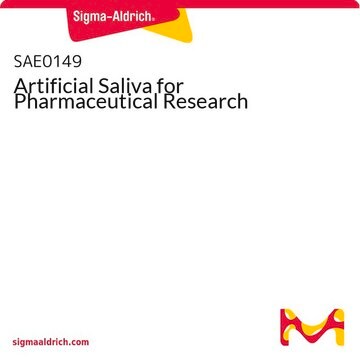Mucin from bovine submaxillary glands, item M3895, can be dissolved/reconstituted in H2O or dilute aqueous alkaline buffers.
M3895
Mucin from bovine submaxillary glands
Type I-S
Sinónimos:
MUC
Seleccione un Tamaño
Seleccione un Tamaño
About This Item
Productos recomendados
origen biológico
bovine submaxillary glands
Nivel de calidad
tpo
Type I-S
Formulario
powder
composición
Bound sialic acids, 9-24%
técnicas
electrophoresis: suitable
Nº de acceso UniProt
temp. de almacenamiento
−20°C
Información sobre el gen
cow ... BSM(286841)
¿Está buscando productos similares? Visita Guía de comparación de productos
Categorías relacionadas
Descripción general
Aplicación
- in the quantification of mucin[3]
- as a component of artificial tear solution[4]
- as a substrate for recombinant sialidase Gardnerella vaginalis[5]
- to investigate a galactose-specific lectin from the red marine alga Ptilota filicina
- to study the characterization of a unique mucin-like glycoprotein secreted by a human endometrial adenocarcinoma cell line (Ishikawa)
Acciones bioquímicas o fisiológicas
Ligadura / enlace
Sustratos
Código de clase de almacenamiento
11 - Combustible Solids
Clase de riesgo para el agua (WGK)
WGK 3
Punto de inflamabilidad (°F)
Not applicable
Punto de inflamabilidad (°C)
Not applicable
Equipo de protección personal
Eyeshields, Gloves, type N95 (US)
Elija entre una de las versiones más recientes:
Certificados de análisis (COA)
¿No ve la versión correcta?
Si necesita una versión concreta, puede buscar un certificado específico por el número de lote.
¿Ya tiene este producto?
Encuentre la documentación para los productos que ha comprado recientemente en la Biblioteca de documentos.
Los clientes también vieron
Artículos
Understand sialic acid structure, function, signaling, and modifications. Easily find products for sialic acid research.
-
What is the recommended method to dissolve Mucin from bovine submaxillary glands, item M3895?
1 answer-
Helpful?
-
Active Filters
Nuestro equipo de científicos tiene experiencia en todas las áreas de investigación: Ciencias de la vida, Ciencia de los materiales, Síntesis química, Cromatografía, Analítica y muchas otras.
Póngase en contacto con el Servicio técnico









